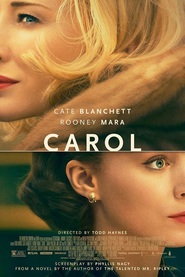
Through the cinematography of Edward Lachman, the film has a slow pace to reflect an artistic piece of film. However, the film feels quick because whenever the artistic shots are used, they are accompanied by a dramatic score. I would argue that this is one of the best instrumental soundtracks since Schindler's List. The melancholy clarinet and build-up of strings give off the emotions that are often found with love. The score acts as a superb accompaniment for the film, and I often felt that the film was accompanying the score.
Lastly, Haynes brings the audience back into the atmosphere of the 1950s. The setting is full of older cars, older outfits, and older society. Not only do we see the old landscape of the US, but we see the older ideologies and morals that the population valued. At one point of the film, I even felt as if the film was shot a long time ago because of what looked like a blatant green screen background. This did not detract from the film, but set up a more realistic feeling for the period piece.
The Bottom Line: Haynes creates a period piece that is artistic in direction and drags the audience back into the conservative society of the 1950s.
Score: 9.6/10

